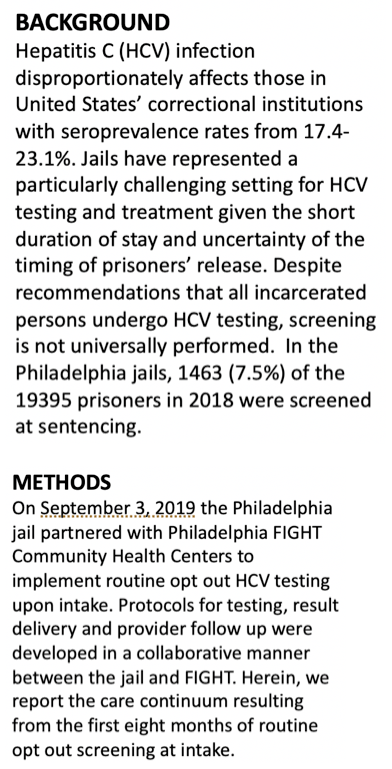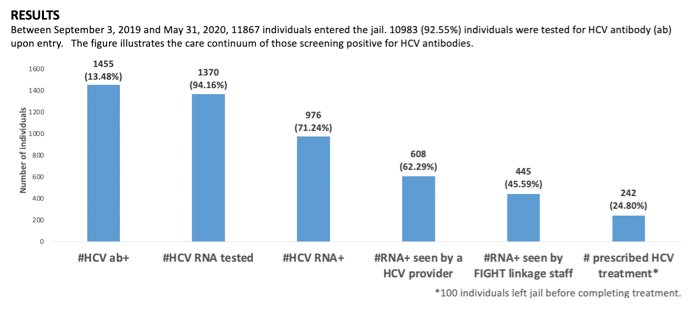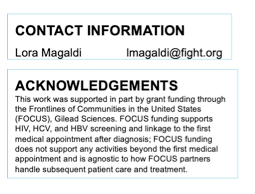 |
 |
 |
| |
Early phase implementation of routine opt out
hepatitis C testing in the Philadelphia jail system
|
| |
| |
AASLD 2020 Nov 11-16
Reported by Jules Levin
L.MAGALDI1, E. ALLEN1, J. ANDERSON1, D. D'AQUILANTE2, R. DOMER-SHANK3, J. EVANS1, B. HERDMAN3, L. HERNANDEZ1, E.KALU2, V. PHILLIPS2, 1T. PRESTON1, A. RIPKIN1, R. RIVERA1, N. ROSARIO1, S. TROOSKIN1 J. KOSTMAN1
1Philadelphia FIGHT Community Health Centers, Philadelphia, PA 2Corizon Healthcare 3Philadelphia Department of Prisons


EARLY PHASE IMPLEMENTATION OF ROUTINE OPT OUT HEPATITIS C TESTING IN THE PHILADELPHIA JAIL SYSTEM
Lora Magaldi1, Ebonee Allen1, Jolie Anderson1, Debra D'Aquilante2, Reed Domer-Shank3, Jalina Evans1, Bruce Herdman4, Leticia Hernandez1, Eke Kalu5, Melanie McCoy6, Ta-Wanda Preston1, Vandelyn Phillips5, Alexandra Ripkin1, Ricardo Rivera1, Nabori Rosario1, Stacey Trooskin1 and Jay Kostman1, (1)Viral Hepatitis, Philadelphia Fight, (2) Infectious Diseases, Corizon Health, (3)Health Information Management, Corizon Health, (4)Medical Operations, Philadelphia Department of Prisons, (5)Medical, Corizon Health, (6)Pharmacy, Philadelphia Fight
Background: Hepatitis C (HCV) infection disproportionately affects those in United States' correctional institutions with seroprevalence rates from 17 .4-23 .1% . Jails have represented a particularly challenging setting for HCV testing and treatment given the short duration of stay and uncertainty of the timing of prisoners' release . Despite recommendations that all incarcerated persons undergo HCV testing, screening is not universally performed . In the Philadelphia jails, 1463 (7 .5%) of the 19395 prisoners in 2018 were screened at sentencing.
Methods: On September 3, 2019 the Philadelphia jail partnered with Philadelphia FIGHT Community Health Centers to implement routine opt out HCV testing upon intake . Protocols for testing, result delivery and provider follow up were developed in a collaborative manner between the jail and FIGHT. Herein, we report the findings of the first eight months of routine opt out screening at intake.
Results: Between September 3, 2019 and May 31, 2020, 11867 individuals entered the jail . 10983 (92 .55%) individuals were tested for HCV antibody (ab) upon entry . 1370 (94 .16%) of 1455 ab+ individuals had reflexive RNA confirmatory testing and 976 (71 .24%) were chronically infected . Of those, 445 were seen by a linkage coordinator from FIGHT, 608 were seen by a jail-based HCV provider, and 242 individuals were prescribed HCV treatment . Of these, 100 (41%) were released from jail before completing HCV treatment . All individuals on treatment left jail with a full course of treatment, linkage to follow up care is an ongoing process.
Conclusion: Establishment of routine opt out HCV screening in a jail setting resulted in more than 90% of individuals entering the jail being screened for HCV . Short duration of incarceration the need for rapid result delivery, increased linkage coordinator visits, and coordination of treatment between the jail and the community are challenges that must be addressed for successful program implementation in a jail setting . Collaboration between health care providers in the correctional system and community is necessary to coordinate HCV services in a high volume, high turnover urban jail.


|
| |
|
 |
 |
|
|